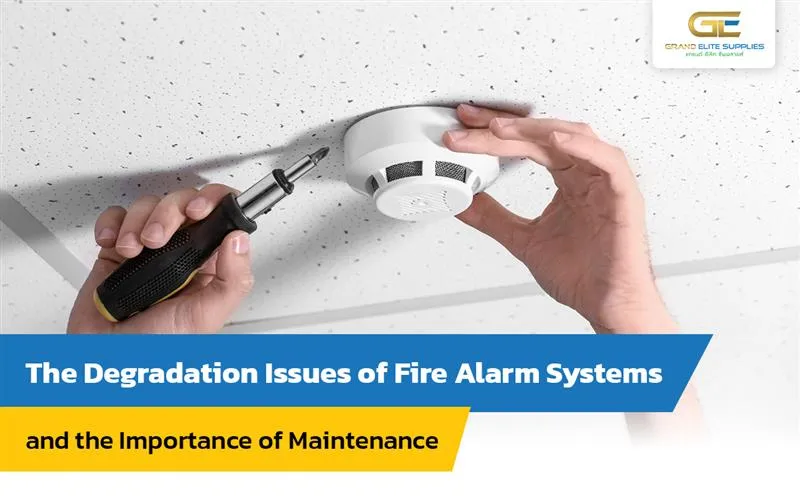A Fire Alarm System, or emergency fire detection and warning system, is designed to prevent hazardous situations and minimize damage when a fire occurs. It operates through automatic processes of detection, notification, and command coordinating multiple devices within a building to respond swiftly to danger.
Although the system is engineered for high accuracy and reliability, in reality, its components can deteriorate over time. This is because the system works in conjunction with several key elements such as smoke detectors, the Fire Alarm Control Panel (FACP), and the Backup Battery. Each component contains electrical circuits and mechanical parts that require regular inspection to ensure functionality.
Maintenance therefore plays a crucial role in ensuring the system’s overall readiness. It verifies that every device within the network continues to operate correctly when a real fire occurs, whether in detecting smoke, transmitting alerts, or activating auxiliary systems within the building. Consistent maintenance not only extends the lifespan of each component but also ensures that the system performs at full efficiency during the most critical moments, when every second can make the difference between safety and disaster.
Fire Alarm System Maintenance Guidelines
- Monthly Inspection
A routine inspection ensures that the Fire Alarm System remains in operational condition at all times. This should be carried out by building personnel or safety officers through the following checks:
- Verify that the Fire Alarm Control Panel (FACP) displays a normal status, with no “Fault” or “Disabled” indicators.
- Check that indicator lights, alarm sounds, and control buttons are all functional.
- Inspect the Backup Battery to ensure sufficient voltage, no leakage, and secure terminals.
- Confirm that Exit Lights and Emergency Lights are operational and properly illuminated.
- Ensure that Smoke Detectors and Manual Call Points are free from dust, obstructions, or physical damage.
Monthly inspections are fundamental to maintaining daily system readiness and detecting potential malfunctions at an early stage before an actual emergency occurs.
- Quarterly System Testing
Quarterly testing focuses on verifying the technical performance of the Fire Alarm System to ensure that each device can transmit and receive signals accurately. This process should be conducted by qualified technicians or authorized maintenance service providers through the following steps
- Test Smoke, Heat, and Flame Detectors — Select a portion of detectors from each zone to verify that they can successfully transmit alarm signals to the Fire Alarm Control Panel.
- Test Audible and Visual Alarm Devices — Check the functionality of devices such as bells, sirens, and flashing strobe lights to confirm that the alarm is both seen and heard clearly in all designated areas.
- Perform a Loop Communication Test — Ensure reliable communication between field devices and the main control panel, confirming that signal transmission is uninterrupted and accurate.
- Test Integration with Auxiliary Devices — Verify the coordination between the Fire Alarm System and other building systems such as elevators, air-conditioning units, fire doors, and public address (PA) systems to ensure synchronized response during emergencies.
- Annual Maintenance
ถือเป็นการตรวจสอบเชิงลึกที่ควรดำเนินการโดยผู้เชี่ยวชาญด้านอัคคีภัย หรือบริษัทที่ได้รับการรับรองตามมาตรฐานวิชาชีพ เพื่อประเมินประสิทธิภาพของระบบทั้งหมดอย่างครอบคลุม โดยทดสอบ
Annual maintenance is a comprehensive inspection that should be conducted by certified fire protection specialists or accredited companies in accordance with professional standards. The objective is to evaluate the overall performance and reliability of the entire Fire Alarm System through the following procedures:
- Test 100% of all detection devices to ensure each unit responds accurately to smoke or heat within its designated zone.
- Clean detector heads to remove accumulated dust and residue that may interfere with sensitivity or delay signal response.
- Verify connectivity with external monitoring stations, if the building is equipped with an automatic fire reporting or remote monitoring system.
- Test system integration with automatic fire suppression systems, such as sprinklers or gas-based extinguishing systems, to confirm proper coordination and activation.
- Inspect the main power supply and backup batteries to ensure they can provide sufficient standby power during emergencies or outages.
- Check the grounding system to prevent electrical leakage, static discharge, and signal interference that could disrupt system operation.
- Documentation and Reporting
After each inspection or maintenance session, a formal Inspection Report should be prepared.
The report must clearly specify the inspection date, the list of tested items, test results, and the name of the responsible personnel. Supporting documents or photographs should also be attached.
These records serve as official evidence for compliance with building safety and fire protection regulations, while also providing a crucial reference for review and investigation in the event of unforeseen incidents.
- Additional Recommendations for Enhanced Safety
- Conduct Fire Evacuation Drills at least once a year, using actual alarm signals from the Fire Alarm System, to ensure that building occupants and staff are familiar with proper evacuation procedures.
- If any device shows an abnormal status, such as a “Fault” indicator or a malfunctioning alarm sound. Repairs should be carried out immediately without waiting for the next scheduled inspection.
- Assign qualified professionals or certified service providers to perform regular inspections and maintenance in accordance with safety standards, ensuring that the entire system remains accurate, reliable, and fully operational at all times.
Fire Alarm System Maintenance by Grand Elite
A Fire Alarm System is a vital mechanism for safeguarding lives and property within any building. It functions through an integrated process of detection, alarm notification, and automatic coordination with other safety systems. Although these systems are designed with high precision and reliability, every component is still subject to wear and deterioration over time.
Proper maintenance should never be overlooked. It ensures that all parts continue to operate accurately and remain ready for use in any emergency.
Regular inspections not only prevent performance degradation but also help detect electrical irregularities before they escalate into major system failures.
Moreover, structured maintenance plays a key role in compliance with building safety laws and international standards such as NFPA 72, which mandates that public buildings and high-rise structures undergo routine fire alarm inspections with formal documentation.
Such compliance not only reduces legal risks but also enhances user confidence that the system will perform effectively when needed most.
As a specialist in Fire Alarm Systems, Grand Elite is committed to designing, installing, and maintaining systems that meet international standards. We provide comprehensive maintenance and inspection services on a scheduled basis, ensuring that every system component remains fully functional during emergencies, whether in office buildings, hotels, factories, or other densely populated environments.
Because at Grand Elite, the safety of lives and property is not just our responsibility. Iit’s our commitment.

